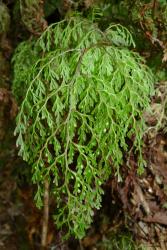- Taxon
- Gallery
- ≡ Trichomanes bivalve G.Forst., Fl. Ins. Austr. 84 (1786)
- ≡ Sphaerocionium bivalve (G.Forst.) C.Presl, Hymenophyllaceae 34 (1843)
- ≡ Meringium bivalve (G.Forst.) Copel., Philipp. J. Sci. 67: 44 (1938)
- = Hymenophyllum spathulatum Colenso, Tasmanian J. Nat. Sci. 2: 184 (1845)
- = Hymenophyllum pyriforme Bosch, Ned. Kruidk. Arch. 5(3): 173 (1863)
Terrestrial, rupestral or occasionally epiphytic ferns. Rhizomes long-creeping, 0.5–0.75 mm diameter, bearing red-brown hairs up to 1 mm long, dense at bases of stipes, scattered elsewhere. Fronds 90–350 mm long. Stipes 16–170 mm long, dark brown throughout, not winged, bearing scattered hairs. Laminae 4–5-pinnatifid, ovate to triangular, 45–210 mm long, 30–165 mm wide, light green, membranous, glabrous or with scattered hairs on costae. Rachises narrowly winged throughout, brown, usually with a few scattered hairs; rachis wings planate or sometimes slightly flexuose, margins entire or very shallowly toothed. Primary pinnae in 7–15 pairs, overlapping, winged throughout; distal portion of primary pinnae strongly incurved acroscopically; distal primary pinnae narrowly ovate, adnate; proximal primary pinnae ovate, more or less stalked; the longest primary pinnae at or near the base, 17–100 mm long, 15–60 mm wide. Secondary pinnae arising both acroscopically and basiscopically, overlapping, winged throughout, adnate; narrowly ovate to ovate on distal primary pinnae, elliptic to ovate on proximal primary pinnae; the longest secondary pinnae 10–60 mm long, 5–30 mm wide. Ultimate lamina segments oblong or linear, up to 5 mm long, 0.5–1.0 mm wide; apices acute or obtuse; margins shallowly toothed, lacking a distinct border; distal segments on primary pinnae strongly curved towards frond apex. Sori borne on short acroscopic and basiscopic segments throughout pinnae, usually solitary or rarely paired, many on each primary pinna, partially immersed in lamina; indusia bivalvate; indusial flaps elliptic, 1–2 mm long, apices obtuse, margins entire; receptacles included within indusial flaps.
Hymenophyllum bivalve is a highly divided, medium-sized filmy fern with a toothed margin. It is larger and more divided than all other New Zealand species with a toothed margin except H. multifidum, which is of comparable size. The two species are very hard to distinguish when sterile, but H. bivalve has laminae which are sometimes slightly larger, less obviously curled downwards, and more shallowly toothed on the margins, especially on the rachis wings. When fertile, the sori of H. bivalve are much smaller and never bent upwards at 90º to the plane of the frond.
North Island: Auckland, Volcanic Plateau, Gisborne, Taranaki, Southern North Island.
South Island: Western Nelson, Sounds-Nelson, Marlborough, Westland, Canterbury, Otago, Southland, Fiordland.
Chatham Islands, Stewart Island.
Altitudinal range: 10–1050 m.
Hymenophyllum bivalve occurs in lowland and montane areas of the North Island from Great Barrier Island (C.P. Winkelmann, Jan. 1886, AK 139881) and Auckland City southwards, but is absent from most of the east coast, and scarce north of latitude 38ºS. It has been recorded from near sea level but is rare below 150 m, growing up to 1050 m on Mt Hauhungatahi. In the South Island it is common west of the main divide, but absent from most of the interior and recorded only sporadically from the east coast. It occurs from 40 m, up to 950 m in the Nelson Lakes District. It extends to Stewart Island and there is a single 19th century collection from the Chatham Islands (WELT P003472).
Also Australia (Queensland, New South Wales).
Occurs under podocarp, beech or broadleaved forest, and in kānuka or open scrub, growing on the ground, on rocks, banks, road cuttings, fallen trunks, at the base of tree trunks, or as a trunk epiphyte. It has been recorded growing on Cyathea dealbata, Dicksonia fibrosa, D. squarrosa, Griselinia littoralis, Libocedrus sp., Litsea calicaris, Weinmannia racemosa and species of Nothofagaceae.
n = 22 (Brownlie 1958).
Hymenophyllum pyriforme was described by van den Bosch (1863) from specimens collected in New Zealand by D’Urville and by J.D. Hooker (the latter "inter specimina H. demissi H. Reg. Berol."). However, no original material has been located in L, identified as Bosch’s main herbarium by Stafleu & Cowan (1976). Only one original specimen (B 200100381), without collector or locality but determined by Bosch in 1857 as H. pyriforme, has been located. Brownsey & Perrie (2016) noted that the specimen at B is clearly original material, and serves to confirm that H. pyriforme is synonymous with H. bivalve, but it does not accord with either of the specimens cited in the protologue. It is a candidate for lectotype if the specimens cited in the protologue cannot be located.
The name Trichomanes pacificum Hedw., sometimes included in the synonymy of Hymenophyllum bivalve, is illegitimate because only the captions and not the plate were published (see Nicolson & Fosberg 2003).
Hymenophyllum bivalve was recorded from the Auckland Islands by Johnson & Campbell (1975) and by Brownsey & Smith-Dodsworth (2000). However, the voucher specimens (OTA 33132, 33133) were misidentified and are actually H. multifidum.








